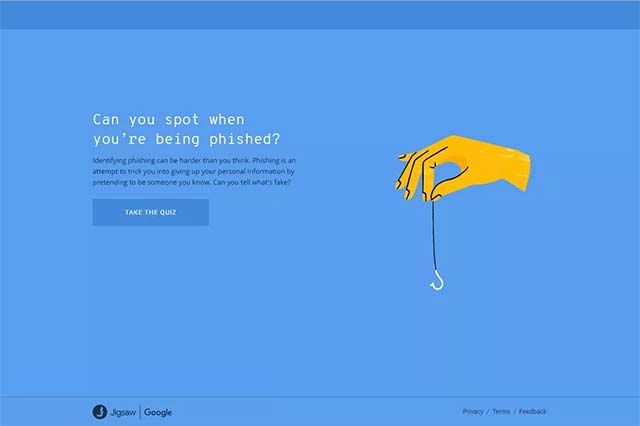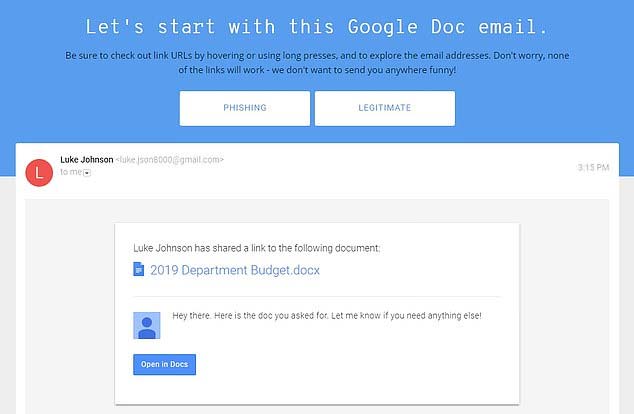Google wants to test user knowledge about phishing emails
On Tuesday, Jigsaw, Google's "technology incubator," quietly released a small test to test users' ability to identify phishing emails.This test will offer a series of interactive questions (eight questions), guide users through a number of popular email scams and check if they can distinguish good phishing signs. is not.

" Until now, Keith Phishing is still the most popular form of phishing attack on the Internet. You may not realize it but an in-depth statistics have shown that 1% of all emails are sent every day. worldwide are phishing emails, designed to steal your password or get you to download malware, so our test has no other purpose than to help lift Awareness of users about potential threats within e-mails being sent every day on the Internet The test is built on security training courses held with more than 10,000 homes. newspapers, activists as well as political leaders' . Jigsaw's representative shares tAlong with a post on the group's personal blog, Jigsaw also said they created a test based on real fraud attempts and by studying the latest techniques being deployed by hackers. .
- Android apps contain malicious code that uses motion sensors to avoid detection
As mentioned, there will be eight specific examples that Google offers to test you, some of which represent legitimate emails while the rest are fraudulent acts. Real examples based on real events, such as in 2016, John Podesta, Hillary Clinton's campaign manager, received a phishing email from Russian hackers to allow them to Access to your email account.
Another example came after a phishing attack that actually targeted Google in 2017, when nearly 1 million users accidentally clicked on a link in an email that sent them to a Google Doc website. toxic.
After each case, Google will give a specific explanation along with the accompanying signs, usually by hovering over URLs to check the location, origin and address of each email.Scammers often try to send emails with URLs that contain the names of big, reputable companies like Google or Dropbox, but will often come with links to attractive deals or gifts to convince people. Use click on that malicious link.
- New malware uses Google Drive as a command-and-control server
Where can you do these tests?

- To test this new Google test, first navigate to the phishingquiz.withgoogle.com website.
- Enter your name and email address (it is not necessary to use your real name and email address).
- Take each question in turn.
- After you complete each situation, Google will provide specific explanations why it is a phishing email or not.
- Users can also take tests multiple times and share their results with friends.
Jigsaw is a team responsible for creating Google's experiments, which aims to solve a wide range of issues in technology space, and often works through relatively simple projects and software.Previously, the group also created troll detection software, an open source tool to help media organizations provide VPN operators and AI tools to filter abusive words.
See more:
- Malware and user security bugs are found in top free VPN applications
- Google paid a fine of 50 million euros after allegedly violating the General Data Protection Act in France
- Google Maps will have a speed limit display feature on Android and iOS apps
- Google will display tedious search results like this when EU copyright laws take effect
 After the Vietnamese market, Go-Jek decided to play 'bloody' with Grab in Singapore
After the Vietnamese market, Go-Jek decided to play 'bloody' with Grab in Singapore Meizu Zero, the first 'no-hole' smartphone in the world has been revealed
Meizu Zero, the first 'no-hole' smartphone in the world has been revealed This is the most beautiful data center in the world, and it is placed in the church of God
This is the most beautiful data center in the world, and it is placed in the church of God Viettel is licensed to test 5G network in Hanoi and Ho Chi Minh City
Viettel is licensed to test 5G network in Hanoi and Ho Chi Minh City Discover the hotel that looks like a spaceship, robot 'serving the teeth' of Alibaba
Discover the hotel that looks like a spaceship, robot 'serving the teeth' of Alibaba Facebook may close the pages or groups of accounts that have seriously violated policies and terms of service
Facebook may close the pages or groups of accounts that have seriously violated policies and terms of service